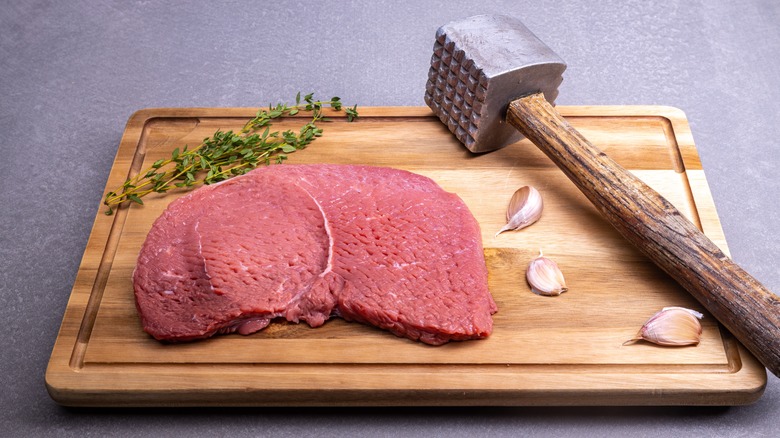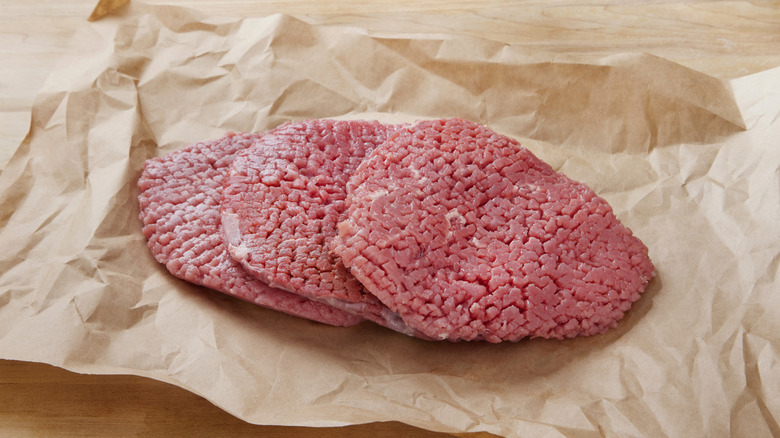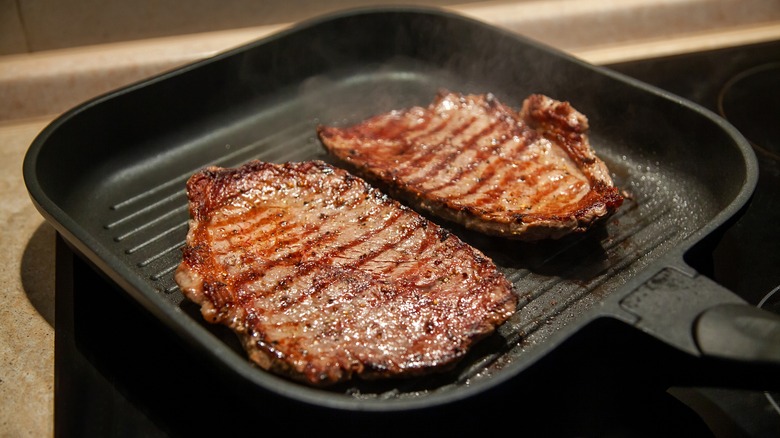Take The Toughness Out Of Cheap Steak With One Easy Technique
If you're hoping for a steak dinner but unwilling to splash the cash on fancier — but typically more expensive — cuts of beef, there's a workaround. You can buy a tougher cut of steak and then tenderize it yourself at home. Don't let your expectations get out of hand: You can't turn cheap meat into prime rib just through tenderizing, but you can get yourself a tasty steak dinner with one.
All you need is a meat mallet: Basically a metal hammer with spikes on one side of the hammer and usually a smooth, flat surface on the other. (Ignore the flat side: It's used more to flatten cuts of meat like chicken or veal cutlets rather than for tenderizing.) They can cost under $10, although there are upscale versions available. The process is simple: You'll just whack that beef with the spiky side of the mallet. This breaks up the connective tissues and collagen in the meat, making it softer and, well, more tender to eat (as those fibers that you're breaking up would keep the meat tougher if you don't tenderize it). To do this, put the beef on a non-stick surface and hammer it from the center outwards. There's no magic number for how much you need to hit it, but ideally, you'll want the beef to have an even thickness, and you'll want to hit every part of the cut with the mallet — so a few dozen hits will probably be fine.
Which cuts need tenderizing?
Speaking generally, any cuts that come from the parts of a cow that move more will be tougher, and therefore may benefit from tenderizing. (Cuts from more sedentary parts of the cow don't need tenderizing: They're already tender since the muscles aren't all worked-out.) Some specific cuts that would benefit from tenderizing are chuck, hangar, flank, and London broil steaks. Cuts like brisket also improve with tenderizing, although few cooks advise treating them like a steak because they're especially fatty.
If you don't have a meat mallet or just don't feel like pounding your steak with a hammer, it's possible to buy pre-tenderized meat from butcher shops and supermarkets. This is often labeled as "cube steak" or "minute steak." The cuts used for these vary but are often top sirloin or top round. They're tenderized by a machine that uses blades or needles to break up fibers in a way that's pretty similar to the mallet method. This machine will often leave a pattern of square shapes on the meat's surface, hence the name "cube steak," and the process is sometimes called "Swissing."
Bear in mind that these methods (with a mallet or a machine) aren't the only way to soften up a tough cut — tenderizing can also be a chemical process, for example, with baking soda or marinades, but that's a whole different topic.
How to cook a tenderized steak
You can't treat a tenderized steak as if it's identical to a premium cut — for one, they're generally a lot thinner thanks to all that hammering, so cooking times may be drastically shorter. If you're dealing with a less-fatty cut like a top round steak, you can pan-fry or sear it like any other steak, but you'll want to avoid cooking it beyond rare, as it'll toughen up. (Fattier cuts will need low, slow cooking like braising or stewing, so you won't want to treat them like a steak at all.)
You'll want to be extra careful to let the meat rest once it's out of the pan, for as long as 15 minutes. This allows the muscle fibers to relax, keeping it as tender as possible — slice the steak against the grain to further break up any fibers that would make the meat tougher. Cube steaks (or other tenderized, lean cuts) are sometimes floured or breaded and cooked as a country-fried or "chicken-fried" steak, to add some bulk to the thinner meat that's been flattened by the tenderizing. Gravy on the side also helps to add some fat and flavor, since you're working with lean beef.


